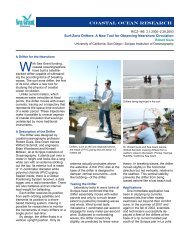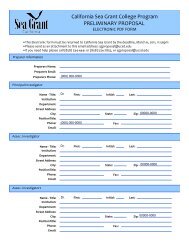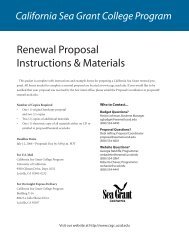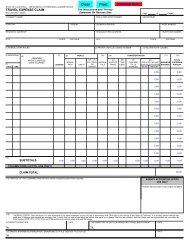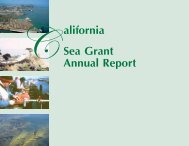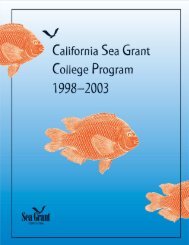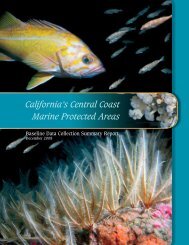The Expansion of Commercial andRecreational FisheriesRiver fisheries for coho (Oncorhynchuskisutch) and Chinook salmon (O.tschawytscha) began in the mid-1800s whilethe ocean salmon fishery, which developedin Monterey Bay in the late 1880s, reachedthe North Coast in the 1920s (Feinberg andMorgan 1980). Information about fisheriesat <strong>Crescent</strong> <strong>City</strong> in the latter 1800s is scant;however, interest in developing the harbor tosupport fishing as well as mining and timberis evident. The first wharf reportedly wasbuilt in 1855 at Whaler’s Island, but was soondestroyed by heavy seas (Scofield 1954).According to Leidersdorf (1975), the U.S.Army Corps of Engineers first consideredimproving the harbor for navigation in 1867,but did not recommend such developmentuntil 1911. Because the harbor was vulnerableto waves and storm surge, the Corps firstbuilt a breakwater, completed in 1930, whichafforded protection from westerly wavesand surge but not from southerly forces. Inaddition, it caused shoaling, which led theharbor district (established in 1935) to initiatemaintenance dredging. Over the next severalyears, additional breakwaters and barriers wereconstructed with varying degrees of success inaddressing this problem.These improvements, along with manytechnological developments following WorldWar II, stimulated the expansion of commercialand recreational fisheries at <strong>Crescent</strong> <strong>City</strong>.Local citizens sought federal assistance forrebuilding the municipal wharf. When none wasforthcoming, they donated materials, moneyand labor to build Citizens Dock, which wascompleted in 1950 (Leidersdorf 1975, Powers2005). Around that time, Scofield (1954) reportedon fishing activity at four piers at <strong>Crescent</strong> <strong>City</strong>,including Citizens Dock:A recently constructed municipal pier(Citizens Dock) is the receiving pointfor about 90% of the fishing boats inthe harbor. The three fish piers areequipped with hoists, scales and truckroads. There is a modern fish canneryand a crab processing plant. Most ofthe boats are salmon trollers and crabboats, but there is some set lining andoccasional deliveries by trawlers.The town is chiefly a salmon and crabport, but other species landed are sole,lingcod, rockfish, albacore tuna, smelt,sablefish, shark and halibut.By the late 1950s, <strong>Crescent</strong> <strong>City</strong> had fourresident commercial fish companies 6 and anumber of fishery-support businesses 7 , andwas the site of substantial recreational andcommercial fishing activity. Fishing vesselswere moored in the lee of Whaler’s Island,and most of the commercial fish offloadingactivities occurred at Citizens Dock. Evidenceof this activity was used to obtain a $250,000loan from the state’s Division of Small CraftHarbors to expand and improve Citizens Dock(Trice 1960). 8<strong>California</strong> Department of Fish and Game(CDFG) Fish Bulletin data provide a measureof this activity beginning in the late 1940s(Figure 2). During the 1950s and 1960s,commercial fishermen in the area landedprimarily crab and salmon The groundfish andshrimp trawl fleets became increasingly active<strong>Crescent</strong> <strong>City</strong> Fishing Community <strong>Profile</strong> 4
45Pounds and ex-vessel value (millions, 2007$)403530252015105019471950All ElseShrimpCrabAlbacoreSalmonGroundfishEx-vessel valuein the late 1960s and early 1970s (due largelyto the use of double-rig trawl nets for shrimp),bringing the total landings at <strong>Crescent</strong> <strong>City</strong>to more than 10 million pounds worth $12.6million (2007$) by 1968.Receiving and processing capacity expanded in theaftermath of the 1964 tsunami with the constructionof two large seafood processing plants. Whengovernment funds for the project came up $40,000short, more than 130 individuals and businessesdonated money to ensure the project’s success(Anon. 1976). In 1970 the Harbor District leasedthe buildings to <strong>Crescent</strong> Fisheries and EurekaFisheries, the latter one of the largest seafoodprocessing companies along the West Coast at thetime. Eureka Fisheries’ new 16,000 ft 2 processingfacility was capable of handling some six millionpounds of shrimp, crab, salmon and groundfishannually (Eureka Fisheries 1992). The considerableincrease in processing capacity (as well as jobs andincome for residents) likely encouraged an increasein the amount of fish landed at the port.1953195619591962196519681971197419771980198319861989199219951998200120042007Figure 2. Pounds and ex-vessel value (2007$) of commercial fishery landings at <strong>Crescent</strong> <strong>City</strong>, 1947–2007(CDFG Fish Bulletin Series). Note: Ex-vessel value data for 1977–1980 are not available.The completion of the inner boat basin providedthe first secure berthing space for recreational andcommercial fishing vessels, and led to a substantialinflux of fishermen into the area, which at thattime was economically depressed following thesharp decline in the local timber industry. As ofMay 1975, the inner harbor’s 300 berths were fullyoccupied by permanent tenants, and there was asubstantial slip waiting list (Leidersdorf 1975).The resident commercial fishing fleet consistedof 100 to 120 boats, many of which were new orupdated vessels compared to those of the previousdecade. In addition to the resident fleet, a growingnumber of transient vessels used the port. In 1981,there were over 1,000 boats making landings atthe port, about ten times the number of residentboats. These boats, many from Eureka and pointssouth or from Oregon, came to access the richlocal fishing grounds and to take advantage of theharbor’s infrastructure, including fish receiving andprocessing capacity.<strong>Crescent</strong> <strong>City</strong> Fishing Community <strong>Profile</strong> 5



